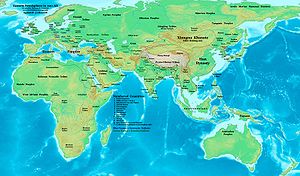AD 1
| Millennium: | 1st millennium |
|---|---|
| Centuries: | |
| Decades: | |
| Years: |
| AD 1 by topic |
|---|
| Leaders |
| Categories |
| Thai solar calendar | 543–544 |
| Tibetan calendar | 阳金猴年 (male Iron-Monkey) 127 or −254 or −1026 — to — 阴金鸡年 (female Iron-Rooster) 128 or −253 or −1025 |
AD 1 (epoch year for the Anno Domini (AD) Christian calendar era, and the 1st year of the 1st century and 1st millennium of the Christian and Common Era (CE).
In the
AD 525 by Dionysius Exiguus
.
The Julian calendar, a 45 BC reform of the Roman calendar, was the calendar used by Rome in AD 1.
Events
By place
Roman Empire
Asia
- Confucius is given his first royal title (posthumous name) of Baocheng Xuan Ni Gong.[3][4]
By topic
Religion
- Birth of Jesus, as assigned by Dionysius Exiguus in his anno Domini era according to at least one scholar.[5][6] However, most scholars think that Dionysius placed the birth of Jesus in the previous year, 1 BC.[5][6] Furthermore, most modern scholars do not consider Dionysius' calculations authoritative, placing the event several years earlier (see Chronology of Jesus).[7]
Births
- Sextus Afranius Burrus, Roman praetorian prefect (d. AD 62)
- Izates II, King of Adiabene (d. AD 54)
Deaths
- Amanishakheto, queen of Kush (Nubia)
Gallery
References
- ^ Fasti Capitolini, AD 1
- Velleius Paterculus, The Roman History, Book II. p 271.
- ^ Thomas A. Wilson (2003), in Xinzhong Yao (Ed.), RoutledgeCurzon Encyclopedia of Confucianism, "Baocheng Xuan Ni Gong", p. 26.
- ^ Book of Han, 12.351
- ^ a b Declercq 2000.
- ^ a b Declercq 2002.
- ^ Dunn 2003.
- ^ Vogt, Katja (February 13, 2024). "Seneca". Stanford Encyclopedia of Philosophy. Retrieved February 23, 2024.
Sources
- Declercq, Georges (2000). Anno Domini: The origins of the Christian Era. Turnhout, Belgium: Brepols. pp. 143–147. ISBN 978-2503510507.
- Declercq, Georges (2002). "Dionysius Exiguus and the introduction of the Christian Era". Sacris Erudiri. 41. Brussels: Brepols: 165–246. ISSN 0771-7776.
Annotated version of a portion of Anno Domini
- Dunn, James D. G. (2003). Jesus Remembered. Christianity in the Making. Vol. 1. Eerdmans Publishing. p. 324. ISBN 978-0802839312.
Footnotes
- ^ Sources disagree regarding the starting day of Julian year Anno Domino I (see leap year error for further information).



